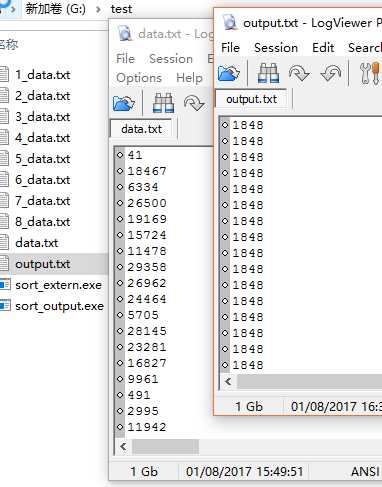标签:output 无法 那是 include har wan img style 条件
引言 - 从最简单的插入排序开始
很久很久以前, 也许都曾学过那些常用的排序算法. 那时候觉得计算机算法还是有点像数学.
可是脑海里常思考同类问题, 那有什么用呢(屌丝实践派对装逼学院派的深情鄙视). 不可能让你去写.
都封装的那么好了. n年后懂了点, 学那是为了用的, 哪有什么目的, 有的是月落日升, 风吹云动~ _φ( °-°)/
本文会举一些实践中排序所用的地方, 解析那些年用过的排序套路, 这里先来个插入排序
// 插入排序 void sort_insert(int a[], int len) { int i, j; for (i = 1; i < len; ++i) { int tmp = a[i]; for (j = i; j > 0; --j) { if (tmp >= a[j - 1]) break; a[j] = a[j - 1]; } a[j] = tmp; } }
插入排序在小型数据排序中很常用! 也是链式结构首选排序算法. 插入排序超级进化 -> 希尔排序, O(∩_∩)O哈哈~.
unsafe code 很需要测试框架, 这里为本文简单写了个测试套路如下
void array_rand(int a[], int len); void array_print(int a[], int len); // // ARRAY_TEST - 方便测试栈上数组, 关于排序相关方面 // #define ARRAY_TEST(a, fsort) \ array_test(a, sizeof(a) / sizeof(*(a)), fsort) inline void array_test(int a[], int len, void(* fsort)(int [], int)) { assert(a && len > 0 && fsort); array_rand(a, len); array_print(a, len); fsort(a, len); array_print(a, len); } // 插入排序 void sort_insert(int a[], int len);
#include <stdio.h> #include <assert.h> #include <stdlib.h>
#define _INT_ARRAY (64)
// // test sort base, sort is small -> big // int main(int argc, char * argv[]) { int a[_INT_ARRAY]; // 原始数据 + 插入排序 ARRAY_TEST(a, sort_insert); return EXIT_SUCCESS; }
#define _INT_RANDC (200) void array_rand(int a[], int len) { for (int i = 0; i < len; ++i) a[i] = rand() % _INT_RANDC; } #undef _INT_SORTC #define _INT_PRINT (26) void array_print(int a[], int len) { int i = 0; printf("now array[%d] current low:\n", len); while(i < len) { printf("%4d", a[i]); if (++i % _INT_PRINT == 0) putchar(‘\n‘); } if (i % _INT_PRINT) putchar(‘\n‘); } #undef _INT_PRINT
单元测试(白盒测试)是工程质量的保证, 否则自己都害怕自己的代码. 软件功底2成在于测试功力是否到位.
顺带扯一点上面出现系统随机函数 rand, 不妨再多说一点, 下面是最近写的48位随机算法 scrand
scrand https://github.com/wangzhione/simplec/blob/master/simplec/module/schead/scrand.c
它是从redis上拔下来深加工的随机算法, 性能和随机性方面比系统提供的要好. 最大的需求是平台一致性.
有机会单独开文扯随机算法, 水也很深. 毕竟随机算法是计算机史上十大重要算法, 排序也是.
一开始介绍插入排序, 主要为了介绍系统内置的混合排序算法 qsort. qsort 多数实现是
quick sort + small insert sort. 那快速排序是什么样子呢, 看如下一种高效实现
// 快速排序 void sort_quick(int a[], int len);
// 快排分区, 按照默认轴开始分隔 static int _sort_quick_partition(int a[], int si, int ei) { int i = si, j = ei; int par = a[i]; while (i < j) { while (a[j] >= par && i < j) --j; a[i] = a[j]; while (a[i] <= par && i < j) ++i; a[j] = a[i]; } a[j] = par; return i; } // 快速排序的核心代码 static void _sort_quick(int a[], int si, int ei) { if (si < ei) { int ho = _sort_quick_partition(a, si, ei); _sort_quick(a, si, ho - 1); _sort_quick(a, ho + 1, ei); } } // 快速排序 inline void sort_quick(int a[], int len) { _sort_quick(a, 0, len - 1); }
这里科普一下为啥把 _sort_quick_partition 单独封装出来. 主要原因是 _sort_quick 是个递归函数,
占用系统函数栈, 单独分出去, 系统占用的栈大小小一点. 轻微提高安全性. 看到这里, 希望以后遇到别人
聊基础也能扯几句了, 高效的操作多数是应环境而多种方式的组合取舍. 突然感觉我们还能翻~
前言 - 来个奇妙的堆排序
堆排序的思路好巧妙, 构建二叉树‘记忆‘的性质来处理排序过程中的有序性. 它是冒泡排序的超级进化.
总的套路可以看成下面这样数组索引 [0, 1, 2, 3, 4, 5, 6, 7, 8] - >
0, 1, 2 一个二叉树, 1, 3, 4 一个二叉树, 2, 5, 6一个二叉树, 3, 7, 8 一个树枝. 直接看代码, 感悟以前神的意志
// 大顶堆中加入一个父亲结点索引, 重新构建大顶堆 static void _sort_heap_adjust(int a[], int len, int p) { int node = a[p]; int c = 2 * p + 1; // 先得到左子树索引 while (c < len) { // 如果有右孩子结点, 并且右孩子结点值大, 选择右孩子 if (c + 1 < len && a[c] < a[c + 1]) c = c + 1; // 父亲结点就是最大的, 那么这个大顶堆已经建立好了 if (node > a[c]) break; // 树分支走下一个结点分支上面 a[p] = a[c]; p = c; c = 2 * c + 1; } a[p] = node; } // 堆排序 void sort_heap(int a[], int len) { int i = len / 2; // 线初始化一个大顶堆出来 while (i >= 0) { _sort_heap_adjust(a, len, i); --i; } // n - 1 次调整, 排好序 for (i = len - 1; i > 0; --i) { int tmp = a[i]; a[i] = a[0]; a[0] = tmp; // 重新构建堆数据 _sort_heap_adjust(a, i, 0); } }
堆排序单独讲一节, 在于它在基础件开发应用中非常广泛. 例如有些定时器采用小顶堆结构实现,
快速得到最近需要执行的结点. 堆结构也可以用于外排序. 还有堆在处理范围内极值问题特别有效.
后面我们会运用堆排序来处理个大文件外排序问题.
/* 问题描述: 存在个大文件 data.txt , 保存着 int \n ... 这种格式数据. 是无序的. 目前希望从小到大排序并输出数据到 ndata.txt 文件中 限制条件: 假定文件内容特别多, 无法一次加载到内存中. 系统最大可用内存为 600MB以内. */
正文 - 来个实际的外排序案例
这里不妨来解决上面这个问题, 首先是构建数据. 假定‘大数据‘为 data.txt. 一个 int 加 char 类型,
重复输出 1<<28次, 28位 -> 1.41 GB (1,519,600,600 字节) 字节.
#define _STR_DATA "data.txt" // 28 -> 1.41 GB (1,519,600,600 字节) | 29 -> 2.83 GB (3,039,201,537 字节) #define _UINT64_DATA (1ull << 28) static FILE * _data_rand_create(const char * path, uint64_t sz) { FILE * txt = fopen(path, "wb"); if (NULL == txt) { fprintf(stderr, "fopen wb path error = %s.\n", path); exit(EXIT_FAILURE); } for (uint64_t u = 0; u < sz; ++u) { int num = rand(); fprintf(txt, "%d\n", num); } fclose(txt); txt = fopen(path, "rb"); if (NULL == txt) { fprintf(stderr, "fopen rb path error = %s.\n", path); exit(EXIT_FAILURE); } return txt; }
以上就是数据构建过程. 要多大只需要调整宏大小. 太大时间有点长. 处理问题的思路是
1. 数据切割成合适份数N 2. 每份内排序, 从小到大, 并输出到特定文件中 3. 采用N大小的小顶堆, 挨个读取并输出, 记录索引 4. 那个索引文件输出, 那个索引文件输入, 最终输出一个排序好的文件
第一步操作切割数据, 分别保存在特定序列文件中
#define _INT_TXTCNT (8)
static int _data_txt_sort(FILE * txt) { char npath[255]; FILE * ntxt; // 需要读取的数据太多了, 直接简单监测一下, 数据是够构建完毕 snprintf(npath, sizeof npath, "%d_%s", _INT_TXTCNT, _STR_DATA); ntxt = fopen(npath, "rb"); if (ntxt == NULL) { int tl, len = (int)(_UINT64_DATA / _INT_TXTCNT); int * a = malloc(sizeof(int) * len); if (NULL == a) { fprintf(stderr, "malloc sizeof int len = %d error!\n", len); exit(EXIT_FAILURE); } tl = _data_split_sort(txt, a, len); free(a); return tl; } return _INT_TXTCNT; }
切割成八份, 每份也就接近200MB. 完整的构建代码如下

// 堆排序 void sort_heap(int a[], int len); // 返回分隔的文件数 static int _data_split_sort(FILE * txt, int a[], int len) { int i, n, rt = 1, ti = 0; char npath[255]; FILE * ntxt; do { // 得到数据 for (n = 0; n < len; ++n) { rt = fscanf(txt, "%d\n", a + n); if (rt != 1) { // 读取已经结束 break; } } if (n == 0) break; // 开始排序 sort_heap(a, n); // 输出到文件中 snprintf(npath, sizeof npath, "%d_%s", ++ti, _STR_DATA); ntxt = fopen(npath, "wb"); if (NULL == ntxt) { fprintf(stderr, "fopen wb npath = %s error!\n", npath); exit(EXIT_FAILURE); } for (i = 0; i < n; ++i) fprintf(ntxt, "%d\n", a[i]); fclose(ntxt); } while (rt == 1); return ti; }
#include <stdio.h> #include <stdint.h> #include <stdlib.h> // // 大数据排序数据验证 // int main(int argc, char * argv[]) { int tl; FILE * txt = fopen(_STR_DATA, "rb"); puts("开始构建测试数据 _data_rand_create"); // 开始构建数据 if (NULL == txt) txt = _data_rand_create(_STR_DATA, _UINT64_DATA); puts("数据已经到位, 开始分隔数据进行排序"); tl = _data_txt_sort(txt); fclose(txt); // 这里分拨的数据构建完毕, 开始外排序过程 return EXIT_SUCCESS; }
执行上面切割代码, 最终生成会得到如下数据内容

1 - 8 _data.txt 数据是分隔排序后输出数据. 随后载开始处理数据进行外排序输出最终结果文件.
struct node { FILE * txi; // 当前是那个文件的索引 int val; // 读取的值 }; // true表示读取完毕, false可以继续读取 static bool _node_read(struct node * n) { assert(n && n->txi); return 1 != fscanf(n->txi, "%d\n", &n->val); } // 建立小顶堆 static void _node_minheap(struct node a[], int len, int p) { struct node node = a[p]; int c = 2 * p + 1; // 先得到左子树索引 while (c < len) { // 如果有右孩子结点, 并且右孩子结点值小, 选择右孩子 if (c + 1 < len && a[c].val > a[c + 1].val) c = c + 1; // 父亲结点就是最小的, 那么这个小顶堆已经建立好了 if (node.val < a[c].val) break; // 树分支走下一个结点分支上面 a[p] = a[c]; p = c; c = 2 * c + 1; } a[p] = node; } struct output { FILE * out; // 输出数据内容 int cnt; // 存在具体多少文件内容 struct node a[]; }; // 数据销毁和构建初始化 void output_delete(struct output * put); struct output * output_create(int cnt, const char * path); // 开始排序构建 void output_sort(struct output * put);
#include <stdio.h> #include <assert.h> #include <stdlib.h> #include <stdbool.h> #define _INT_TXTCNT (8) #define _STR_DATA "data.txt" #define _STR_OUTDATA "output.txt" // // 对最终生成数据进行一种外排序尝试 // int main(int argc, char * argv[]) { // 构建操作内容 struct output * put = output_create(_INT_TXTCNT, _STR_OUTDATA); output_sort(put); // 数据销毁 output_delete(put); return EXIT_SUCCESS; }
以上是处理的总流程, 对于构建和销毁部分展示在下面
void output_delete(struct output * put) { if (put) { for (int i = 0; i < put->cnt; ++i) fclose(put->a[i].txi); free(put); } } struct output * output_create(int cnt, const char * path) { FILE * ntxt; struct output * put = malloc(sizeof(struct output) + cnt * sizeof(struct node)); if (NULL == put) { fprintf(stderr, "_output_init malloc cnt = %d error!\n", cnt); exit(EXIT_FAILURE); } put->cnt = 0; for (int i = 0; i < cnt; ++i) { char npath[255]; // 需要读取的数据太多了, 直接简单监测一下, 数据是够构建完毕 snprintf(npath, sizeof npath, "%d_%s", _INT_TXTCNT, _STR_DATA); ntxt = fopen(npath, "rb"); if (ntxt) { put->a[put->cnt].txi = ntxt; // 并初始化一下数据 if (_node_read(put->a + put->cnt)) fclose(ntxt); else ++put->cnt; } } // 这种没有意义, 直接返回数据为empty if (put->cnt <= 0) { free(put); exit(EXIT_FAILURE); } // 构建数据 ntxt = fopen(path, "wb"); if (NULL == ntxt) { output_delete(put); fprintf(stderr, "fopen path cnt = %d, = %s error!\n", cnt, path); exit(EXIT_FAILURE); } put->out = ntxt; return put; }
核心排序算法 output_sort ,
// 28 -> 1.41 GB (1,519,600,600 字节) | 29 -> 2.83 GB (3,039,201,537 字节) #define _UINT64_DATA (1ull << 28) // 开始排序构建 void output_sort(struct output * put) { int i, cnt; uint64_t u = 0; assert(put && put->cnt > 1); cnt = put->cnt; // 开始构建小顶堆 i = cnt / 2; while (i >= 0) { _node_minheap(put->a, cnt, i); --i; } while (cnt > 1) { ++u; // 输出数据, 并且重新构建数据 fprintf(put->out, "%d\n", put->a[0].val); if (_node_read(put->a)) { --cnt; // 交换数据, 并排除它 struct node tmp = put->a[0]; put->a[0] = put->a[cnt]; put->a[cnt] = tmp; } _node_minheap(put->a, cnt, 0); } // 输出最后文件内容, 输出出去 do { ++u; fprintf(put->out, "%d\n", put->a[0].val); } while (!_node_read(put->a)); printf("src = %llu, now = %llu, gap = %llu.\n", _UINT64_DATA, u, _UINT64_DATA - u); }
最终得到数据 output.txt

以上就是咱们常被面试过程中问及的大数据瞎搞问题, 一种简陋的解决方案. 当然事情远远才刚刚开始!
学生阶段面试吹一波感觉是可以了~ 扯一点, 年轻时候多吹一点NB, 以后也就只能看着别人~
后记 - 等我回家
等我回家 - http://music.163.com/#/song?id=477890886

最近很羡慕陈胜吴广, 未来深不可测. 假如我们都是直男癌, 一定不要忘记有过的血气方刚 ~
标签:output 无法 那是 include har wan img style 条件
原文地址:http://www.cnblogs.com/life2refuel/p/7265077.html